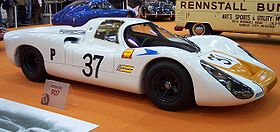Porsche 907
| Porsche 907 | |
|---|---|
 |
|
| Overview | |
| Production | 1967-1968 |
| Chronology | |
| Predecessor | Porsche 910 |
| Successor | Porsche 908 |
The Porsche 907 was a sportscar racing prototype built by Porsche in 1967 and 1968.
The 907 was introduced at the 1967 24 Hours of Le Mans. As suggested by Ferdinand Piëch, the position of the driver was moved from the traditional left (as in German road cars) to the right as this gives advantages on the predominant clockwise race tracks.
With a new longtail body, the 907s reached 302 km/h (190 mph) on the straight even though they used the reliable 220 hp Porsche 910 2000cc 6-cyl rather than the more powerful 8-cyl. Also, vented brake disks were used as standard from now. The best Porsche 907 finished 5th, beaten only by Ford and Ferrari with their much bigger engines.
As the record-breaking performances of the 7.0L V8-powered Ford had triggered rumors about a future rule change, Porsche started to prepare themselves in summer of 1967. The 907 was equipped with the 270 hp 2200cc 8-cyl which was then modified for the rules of the new 3 litre prototype category that was announced in late 1967 to come in effect already in 1968. An engine with the full 3000cc would have to be developed first, though, to be introduced in the future Porsche 908.
From 1968, the big V8 and V12 prototypes of Ford and Ferrari were banned, and Porsche hoped to secure the World Sportscar Championship and maybe an overall win at Le Mans as the competition at Ford, Matra and Alfa Romeo was not prepared with suitable 3000cc prototypes yet, either. Ferrari even sat out the whole of 1968 as a protest against the rule change. Apart from the former 2000cc-class rivals Alfa Romeo T33/2 and Renault-powered Alpine, 5000cc sportscars were also permitted to enter if at least 50 of them had been built. This loophole was intended to fill the grid with cars dating mainly from 1965, like Ford GT40 and Lola T70.
...
Wikipedia
